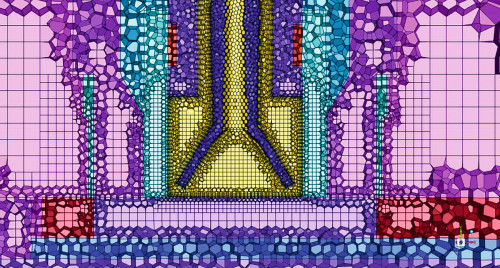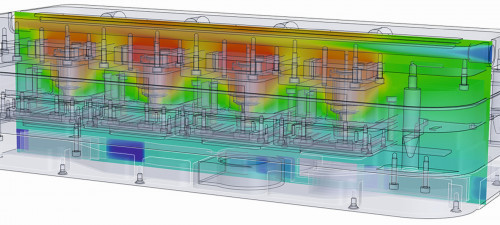What happens when we inhale nanoparticles emitted by a laser printer, for example? Can they damage the respiratory tract or perhaps even other organs? To answer such questions, Fraunhofer researchers are developing the "NanoCube" exposure device.
The NanoCube's integrated multi-organ chip from the laboratory of TU Berlin and its spin-off TissUse detects the interaction of nanoparticles with lung cells as well as their uptake into the bloodstream and possible effects on the liver.
A laser printer right next to the workplace is a practical thing. However, just like 3D printers, the devices can potentially emit aerosols during operation that contain nanoparticles - particles between one and one hundred nanometers in size. For comparison: a hair is around 60,000 to 80,000 nanometers thick. Nanoparticles are also produced in road traffic, for example through the abrasion of tires. So far, however, little is known about how these particles affect the human body when they are inhaled through the lungs. Such studies have so far only been possible using animal experiments. In addition, large quantities of samples of the respective aerosol would have to be collected at great expense.
Researchers from the Fraunhofer Institute for Toxicology and Experimental Medicine ITEM and the Fraunhofer Institute for Algorithms and Scientific Computing SCAI, with the participation of TU Berlin and its spin-off TissUse GmbH, are working on the "NanoINHAL" project funded by the Federal Ministry of Education and Research (BMBF) to investigate the effects of nanoparticles on the human body. The biological effect of the aerosols is determined directly and simply using in-vitro methods without animal testing. This is made possible by a combination of two existing technologies: The Humimic Chip3 multi-organ chip from TU Berlin and its spin-off TissUse and the P.R.I.T. ExpoCube, a Fraunhofer ITEM development. The Humimic Chip3 is a chip the size of a standard laboratory slide measuring 76 x 26 mm. Tissue cultures miniaturized 100,000-fold can be placed in it, with nutrient solutions supplying the tissue cultures via micropumps. In this way, tissue samples from the lungs and liver and their interaction with nanoparticles, for example, can be artificially simulated.
Four of these multi-organ chips fit into the P.R.I.T. ExpoCube. This is an exposure device for investigating airborne substances such as aerosols using in-vitro methods. Using a sophisticated system of micropumps, heating electronics, aerosol lines and sensors, the ExpoCube is able to expose the cell samples on the multi-organ chip at the air-liquid interface to various aerosols or nanoparticles - just as happens in the human eye - in a controllable and reproducible manner.
 Calculation grid for the thermal simulation with an enlarged representation of the NanoCube exposure device. In yellow are the aerosol areas, the other areas are either components or air areas (Photo: Fraunhofer SCAI)
Calculation grid for the thermal simulation with an enlarged representation of the NanoCube exposure device. In yellow are the aerosol areas, the other areas are either components or air areas (Photo: Fraunhofer SCAI)
 A snapshot of the simulation shows the temperature distribution in the NanoCube with the multi-organ chips inside. The analysis of the temperature distribution helps to optimize the structure of the NanoCube (Photo: Fraunhofer SCAI)
A snapshot of the simulation shows the temperature distribution in the NanoCube with the multi-organ chips inside. The analysis of the temperature distribution helps to optimize the structure of the NanoCube (Photo: Fraunhofer SCAI)The nanoparticles flow through a micro-pipe, from which several branches lead downwards to direct the air and nanoparticles to the four multi-organ chips. If lung cells are to be exposed at the air-liquid interface, numerous parameters play a role, for example the temperature, the flow of the culture medium in the chip, but also the aerosol flow. That's what makes it so complicated. At the end of the project, the NanoCube and multi-organ chip will allow detailed studies of aerosols in vitro. It will then be possible for the first time to investigate the direct effects of potentially harmful nanoparticles on the respiratory tract and at the same time possible effects on other organs, such as the liver.
But how can aerosols, and nanoparticles in particular, be directed onto the lung cells in such a way that a defined quantity is deposited on the cell surface? The researchers investigated these and similar aspects in a simulation. In doing so, they had to overcome particular challenges: For example, the physical and numerical models required for a detailed simulation of nanoparticles are significantly more complex than for particles with a larger diameter. This in turn leads to a significant increase in computing times. The computationally intensive simulation helps to optimize the real test system. One example: as mentioned above, the aerosol must flow through a pipe from which several branches extend downwards in order to guide the nanoparticles onto the multi-organ chips - with conditions at the pick-up points that are as identical as possible. However, the inertial forces of the nanoparticles are low, so it would be more difficult to move the particles from the diverted flow onto the cell surface. Gravity alone is not enough here. The researchers solve the problem by making use of the phenomenon of thermophoresis. This is a force in a fluid with a temperature gradient that causes the particles to migrate to the cooler side. The simulations show: When the aerosol is heated and flows through the pipe, while the cells are naturally cultivated at body temperature, the nanoparticles move towards the cells.
The researchers also used simulation to investigate how the highest possible temperature gradient can be achieved without harming the cells and how the corresponding device must be designed for this. This also includes how different flow velocities and geometries of the supply lines affect the uptake. The temperature distribution in the exposure device was also optimized by selecting different materials, adapting the geometry and modifying the cooling and heating design. The first prototype of the NanoCube exposure device, including the multi-organ chip, should be ready in the autumn, followed by the first experiments with the system. Instead of aerosols from printers, the Fraunhofer researchers are initially using reference particles, including nanoparticles of zinc oxide or so-called "carbon black", i.e. printer ink. In future practical applications, the measuring system is to be set up directly where the nanoparticles are produced, for example next to the laser printer.
As part of the NanoINHAL project, an innovative test system is being created that will enable the investigation of the toxic effects of airborne nanoparticles on cells in the respiratory tract and lungs, but also on downstream organs such as the liver. By combining the two organ systems in a microphysiological system, the uptake and distribution of nanoparticles in the organism can also be investigated. In future, the test system will provide data on the long-term effects of inhaled nanoparticles and their biokinetics. This is an important contribution to assessing the potential health risks posed by these particles.
Source: Fraunhofer ITEM


